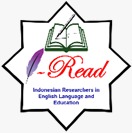Different Learning Style, Different Performance in TOEFL Reading: Is That Right?
DOI:
https://doi.org/10.22219/englie.v3i2.21956Keywords:
learning style, reading performance, TOEFL reading testAbstract
This present study has aim to answer a question “is there any relationship between students’ learning styles in TOEFL reading comprehension test?”. Therefore, this study was done for knowing whether there is a significant relationship between students’ learning styles in reading comprehension performance on the TOEFL test or not. The University of Islam Malang was chosen as the place to conduct this study with 37 students in the fourth semester of English Department. A questionnaire and TOEFL reading test were used as the instruments in this study to find the result. Both of the instruments were done in 45 minutes. Based on the results that were counted statistically using SPSS, the findings showed that the score of visual (M = 43,22), kinesthetic (M = 38,70), and auditory (M = 35,00) for reading achievement. Moreover, it also showed that df = 2, F = 1.102, P = .344. The results informed that there is no significant difference between students’ learning style in TOEFL reading comprehension performance. Due to limitations that exist in this quantitative study, future researchers are suggested to do research which broader population involvement and include reading strategies to give more insightful results regarding reading comprehension that might be useful for the learning process.
Downloads
References
Alek, Farkhan, M., Nurlia, V., & Haucsa, G. M. (2019). University Students’ Perception on TOEFL as a Graduation Requirement: A Case in UIN Syarif as a Graduation Requirement: A Case in UIN Syarif. ELITE JOURNAL: Journal of English Linguistics, Literature, and Education, 51-63.
Brown, H. D. (2000). Principles of language teaching and learning (Fourth Edition). New York: Longman.
Fajri, D. R. (2019). An Analysis of Student Strategy in Completing TOEFL Reading Comprehension Test. Journal of English Language Teaching and Literature (JELTL), 84-91.
Fithrotunnisa, E. D. (2015). The comparative analysis of students’ learning style on aheir achievement in reading skill. (Skripsi). Faculty of Tarbiyah and Teachers’ Training: Syarif Hidayatullah State Islamic University. Jakarta.
Fleming, N. D. (2014, October 1). The nature of preference. https://vark-learn.com/wp- content/uploads/2014/08/THE-NATURE-OF-PREFERENCE.pdf
Jaelani, S. R., Wathoni, H., Purnama, B., Harianto, H., & Wadi, A. S. (2022). he Students’
Ability in Reading Comprehension of TOEFL for EFL Learners. JSHP, 60-66.
Jaya, H. P. (2019). Learning Styles Used and English Proficiency of the Students of English Education Study Program Faculty of Teacher Training and Education Sriwijaya University. HOLISTICS JOURNAL, 17-22.
Marzulina, L., Pitaloka, N. L., & Yolanda, A. D. (2019). Learning Styles and English Proficiency of Undergraduate EFL Students at One State Islamic University in Sumatera, Indonesia. Jurnal Pendidikan dan Pengajaran, 214-228.
Netta, A., & Trisnawati, I. K. (2019). Acehnese Undergraduate Students’ Strategies in Preparing for Toefl Prediction: a Preliminary Study. Englisia Journal, 7(1), 41–52. https://doi.org/10.22373/ej.v7i1.5779
Nigari, H. N. M., Rajabi, P., Khalaji, H. R. (2016). The effect of jigsaw task on Iranian EFL learners’ reading skills improvement. International Journal of Educational Investigations, 3(1), 10-19.
Ningsih, I. H., Winarni, R., & Roemintoyo. (2019). The Importance of Early Reading Learning in the Face of 21st Century Education. AL-ASASIYYA: Journal Basic Of Education, 196-205.
Pratiwi, D. I., Atmaja, D. S., & Prasetya, H. W. (2021). Multiple E-Learning Technologies on Practicing TOEFL Structure and Written Expression. JEES (Journal of English Educators Society), 6(1), 105–115.
Rahwanda, D., Yufrizal, H., & Sinaga, T. (2019). The Effect of Learning Style Based Activities on Reading Achievement of Nursing Students. U-JET: Unila Journal of English Teaching.
Rezaei, A., Rahimi, M. A., & Talepasan, S. (2012). Exploring EFL learners reading comprehension problems in reading ESP text. Sino-US English Teaching, 9(3), 982-987.
Richards, J. C. & Renandya, W. A. (2002). Methodology in Language Teaching: An Anthology of Current Practice. Cambridge University Press.
Rujani, M. R. (2019). Correlational Study Between Learning Style and Reading Comprehension at University Level Students. Advances in Social Science, Education and Humanities Research, 45-50.
Sulistyo, G.H. (2009). TOEFL in a Brief Historical Overview from PBT to IBT. Bahasa dan Seni, 116-127
Zalha, F. B., Alfiatunnur, & Kamil, C. A. (2020). Strategies in dealing with the Reading Section of ‘TOEFL Prediction’: a Case of Aceh EFL Learners. IJEE : Indonesian Journal of English Education, 159-171.
Downloads
Published
How to Cite
Issue
Section
License
Copyright (c) 2022 Elisa Ratih, Khilda Husnia Abidah

This work is licensed under a Creative Commons Attribution-ShareAlike 4.0 International License.
Authors who publish with English Learning Innovation (englie) agree to the following terms:
- For all articles published in English Learning Innovation (englie), copyright is retained by the authors. Authors give permission to the publisher to announce the work with conditions. When the manuscript is accepted for publication, the authors agree to automatic transfer of the publishing right to the publisher.
- Authors retain copyright and grant the journal right of first publication with the work simultaneously licensed under a Creative Commons Attribution-ShareAlike 4.0 International License that allows others to share the work with an acknowledgement of the work's authorship and initial publication in this journal.
- Authors are able to enter into separate, additional contractual arrangements for the non-exclusive distribution of the journal's published version of the work (e.g., post it to an institutional repository or publish it in a book), with an acknowledgment of its initial publication in this journal.
- Authors are permitted and encouraged to post their work online (e.g., in institutional repositories or on their website) prior to and during the submission process, as it can lead to productive exchanges, as well as earlier and greater citation of published work (See The Effect of Open Access).
This work is licensed under a Creative Commons Attribution-ShareAlike 4.0 International License.
















1.png)












